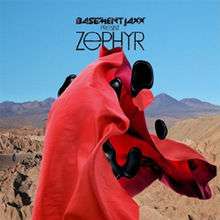Zephyr (Basement Jaxx album)
Zephyr is the sixth studio album by English electronic music duo Basement Jaxx. Released in 7 December 2009 as an extended play (EP) internationally.
| Zephyr | ||||
|---|---|---|---|---|
 | ||||
| Studio album / EP by | ||||
| Released | 7 December 2009 | |||
| Recorded | March 2007 - September 2009 | |||
| Genre | Chill-out | |||
| Length | 33:16 | |||
| Label | ||||
| Producer |
| |||
| Basement Jaxx chronology | ||||
| ||||
Background
The group had originally planned on recording a double album, with one album consisting of more ambient and mellow songs and the other traditional dance music tracks. However, the group decided on releasing Scars on its own, with Zephyr as its follow-up.[1]
Felix Buxton told PopMatters: "[As] we were very keen on kind of doing a double-album. And then it’s just one of those things: you feel [you’re in] your progressive rock phase. It’s very Spinal Tap to do a double-album, and acts [sometimes] take themselves too seriously, so we were at that point [where] we want to take ourselves seriously; and also we also always enjoy doing the soundscape stuff."[2]
Zephyr was released on 7 December 2009 by record label XL.[3] Initially, the album was only released as a digital download, but a physical release followed in March 2010.
The track 'Hip Hip Horay' was created for the Tate Modern as part of a series of tracks commissioned to be played alongside paintings[4]. The track was inspired by the paiting by Karel Appel, and includes cello, piano and organ by Jack Nunn[5].
"Walking in the Clouds" features the voice of Joe Benjamin, a 70-year-old Bermudan man that walks around Brixton with "a Stetson hat, a large stick and a kind of poncho." Buxton befriended him when he used to live there, then he invited Benjamin to the studio to record "Benjilude", an interlude from their 2003 album Kish Kash.[6][7]
Reception
| Review scores | |
|---|---|
| Source | Rating |
| AllMusic | |
| Pitchfork | 7.0/10[9] |
AllMusic called the album an "altogether more reflective affair [than Scars] that allows Buxton and Ratcliffe to showcase their unique interpretation of a chillout album", though criticising the album's short length.[8]
Track listing
| No. | Title | Length |
|---|---|---|
| 1. | "Intro" | 0:19 |
| 2. | "Peace of Mind" | 7:12 |
| 3. | "Alkazaar" | 3:41 |
| 4. | "Hip Hip Hooray" | 2:53 |
| 5. | "Walking in the Clouds" | 3:39 |
| 6. | "Where R We Now" | 5:14 |
| 7. | "Dark Vale" | 1:32 |
| 8. | "Check the Fuse" | 0:54 |
| 9. | "Sunrising" | 2:01 |
| 10. | "Ascension" | 5:51 |
Charts
| Chart (2009-10) | Peak position |
|---|---|
| Japanese Albums (Oricon)[10] | 236 |
| UK Dance Albums (OCC)[11] | 12 |
References
- "Zephyr released Monday!". basementjaxx.net. Retrieved 13 September 2011.
- Sawdey, Evan (29 October 2014). "Power to the People: An Interview with Basement Jaxx". PopMatters. PopMatters Media, Inc. Retrieved 8 September 2016.
- "Zephyr [Import]". Amazon.com. Retrieved 13 September 2011.
- "Tate | Tate Tracks". web.archive.org. 21 June 2008. Retrieved 4 April 2019.
- "Basement Jaxx - Zephyr (CD, Album) | Discogs". web.archive.org. 4 April 2019. Retrieved 4 April 2019.
- Richards, Sam (15 December 2012). "Basement Jaxx's favourite tracks". The Guardian. Retrieved 28 July 2016.
- Kleinfeld, Justin (13 November 2003). "Basement Jaxx: An insider's look at Kish Kash" (Google Books). CMJ New Music Report. CMJ. 77 (835): 36. ISSN 0890-0795. Retrieved 28 July 2016.
- Jon O'Brien. "Zephyr - Basement Jaxx". Allmusic. Retrieved 18 September 2011.
- Jess Harvell (22 January 2010). "Basement Jaxx: Zephyr EP". Pitchfork. Retrieved 18 September 2011.
- スカーズ/ゼファー スペシャル・エディション (in Japanese). Oricon. Retrieved 12 September 2014.
- "Official Dance Albums Chart Top 40". Official Charts Company. Retrieved 12 September 2014.